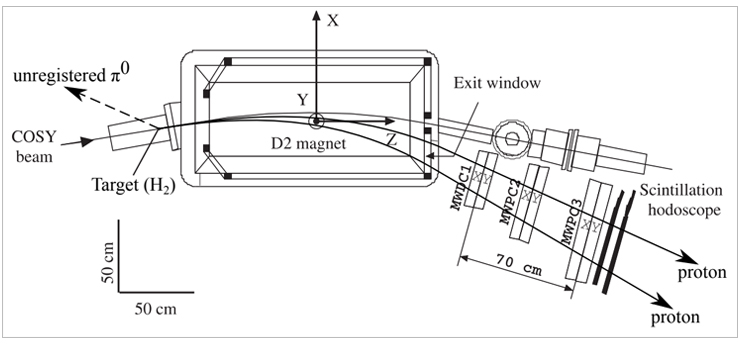DLNP scientists advanced in study of dibaryon resonances
News, 23 January 2023
In January 2023, the Physical Review C journal published an article “Resonant behavior of the pp→{pp}sπ0 reaction at the energy √s=2.65 GeV” [Phys. Rev. C 107, 015202] by JINR scientists. In their work, authors report on the first observation of a peak in the energy dependence of the pp→{pp}sπ0 reaction at the proton kinetic energy 1.9 GeV (√ s = 2.65 GeV). The obtained result indicates the excitation of a new, isovector D(2650) resonant state that may be a dibaryon resonance system consisting of two excited baryons ∆(1232) and N*(1440).
Employees of the Laboratory of Nuclear Problems Dmitry Tsirkov, Bota Baimurzinova, Vladimir Komarov, Anatoly Kulikov, Ainur Kunsafina, Vladimir Kurbatov, Zhanibek Kurmanalyiev, and Yuri Uzikov are authors of the article. The scientists received their result during the analysis of experimental data obtained at the ANKE Facility of the COSY Accelerator in Jülich (Germany) with their participation.
 Scheme of the ANKE spectrometer ©️ Physical Review C
Scheme of the ANKE spectrometer ©️ Physical Review C
In hadron physics, the theory of strong interactions assumes the existence of quasibound systems, called dibaryon resonances in literature, along with baryons and mesons. Dibaryon resonances should be in the form of peaks in the cross-section of interaction of two baryons in their ground states during the collision.
One of the approaches called the quark approach considers dibaryon resonances as sixquark states. Another one referred to as the meson-baryon approach considers them as excited states from ordinary three-quark baryons that can be both in their ground states and in known excited inner states.
The search for these systems in experiments has been going on (with varying success) for more than 50 years. According to the authors of the article, the isoscalar resonance in the proton-neutron system with an invariant mass of 2380 MeV and width of 70 MeV discovered in the full cross section of the pn→dπ0π0 reaction by the WASA@COSY collaboration is considered in literature as the most realistic candidate for the role of the dibaryon resonance with zero strangeness. In the theoretical interpretation of this state within the framework of quark and hadron models, it is either a quantum superposition of two Δ(1232) isobars and a six-quark component producing a dibaryon as an exotic bound state, or a quasi-bound state of ordinary hadrons, for example, in the Δ(1232)πN system.
The recent publication in the Physical Review C journal is not the first article by physicists of the Laboratory of Nuclear Problems on dibaryon resonances. In 2018, in the article by a DLNP chief researcher Vladimir Komarov and others [Eur.Phys.J.A 54 (2018) 206], JINR specialists discovered the resonant behavior in the cross section of the pd→pdππ reaction. Scientists interpreted it as the excitation of the deuteron to the dibaryon resonance D(2380), previously discovered by the WASA@COSY collaboration in another reaction.
Further study of dibaryon resonances requires new experimental data.
To solve the problem of the nature of the dibaryon resonance and its internal structure, it is essentially important to obtain new experimental information about this and other similar states. Therefore, the DLNP physicists have analysed the experimental data obtained in pp- и pd-interactions at the ANKE facility of the COSY accelerator in Jülich (Germany) with their participation.